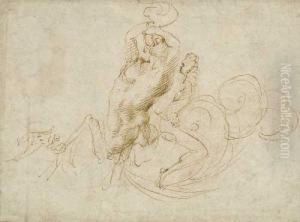Giovanni Angelo Montorsoli Paintings
Giovanni Angelo Montorsoli was an Italian sculptor of the Florentine Renaissance, born in 1507 in Montorsoli, now a fraction of the comune of Vaglia, Tuscany. He was a notable student of Michelangelo Buonarroti and is often considered one of his most talented pupils. His style was significantly influenced by his mentor, which can be seen in his attention to anatomical precision and dynamic forms.
Montorsoli entered the Dominican Order and was also known as Fra' Giovanni Agnolo Montorsoli. His religious commitment did not prevent him from pursuing a career in art; in fact, it may have facilitated his travels and commissions in connection with the Church. He worked primarily in Florence but also spent time in Rome, where he was exposed to the burgeoning artistic innovations of the High Renaissance.
One of Montorsoli's most significant contributions was his work on the Medici Chapel in San Lorenzo, Florence, where he assisted Michelangelo with the sculptures and architectural elements. Although his work there was part of a larger ensemble, it helped to establish his reputation as a master sculptor. After Michelangelo left Florence for Rome, Montorsoli continued the work on the chapel and was responsible for completing some of the statues that Michelangelo had left unfinished.
In addition to his sculptural works, Montorsoli took on architectural commissions. He was involved in the fortification of the port of Messina in Sicily, where he also created the Fountain of Orion, which is still considered a masterpiece of Mannerist sculpture. The fountain shows an intricate understanding of water dynamics and an elaborate allegorical program, reflecting the sophistication of Italian courtly art of the period.
Montorsoli's influence extended beyond his lifetime through his students and the spread of his stylistic approaches. He died in 1563, leaving behind a legacy that encapsulates the transition from the High Renaissance to the Mannerist style. His works are characterized by their elegance and expressiveness, and they continue to be studied for their technical mastery and historical significance within the context of 16th-century Italian art.
